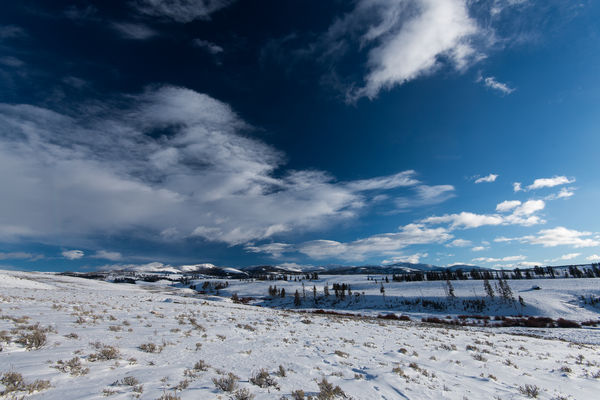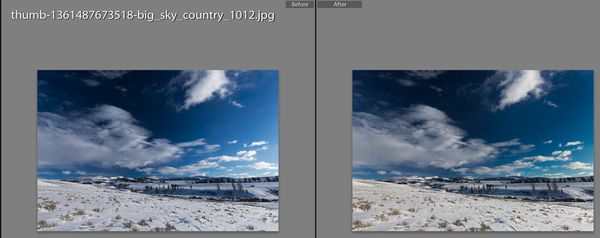Circular Polarizer on Wide Angle
Feb 21, 2013 18:01:18 #
Since circular polarizers affect color depending on the angle relative to the sun, usually you read they shouldn't be used with a super wide angle lens.
I tend to leave mine on most of the time anyway. I often appreciate what is does for my shots. Occasionally, it makes the sky fairly uneven across the frame. Attached is a photo shot at 16mm with a full frame camera. This is the most uneven sky I could find among some recent shots I took. It doesn't really bother me that the sky isn't uniform.
Just wondering what others think? Is there something I can do in post processing if I want the sky to be more uniform?
I tend to leave mine on most of the time anyway. I often appreciate what is does for my shots. Occasionally, it makes the sky fairly uneven across the frame. Attached is a photo shot at 16mm with a full frame camera. This is the most uneven sky I could find among some recent shots I took. It doesn't really bother me that the sky isn't uniform.
Just wondering what others think? Is there something I can do in post processing if I want the sky to be more uniform?
Shot with circular polarizer, 16mm, D800

Feb 21, 2013 18:33:39 #
Karl P
Loc: Leigh NW UK
I looked at the photo beofre reading your post - My first thought was - look at that great sky with interest and vibrant colour throughout
After reading your post - I thought I must get a polorizor to try and recreate this type of image
so in answer to your question - in my opinion - no I think this has enhanced the photo (by the way I am a complete novice with the camera but try to say what I like about a photo rather than the technicalities)
I think it would also be best to allow download to see in full format - I viewed on Ipad and expanded to full screen and it makes a huge difference
No doubt you will have lots of varied answers to this - will watch with interest
Karl
After reading your post - I thought I must get a polorizor to try and recreate this type of image
so in answer to your question - in my opinion - no I think this has enhanced the photo (by the way I am a complete novice with the camera but try to say what I like about a photo rather than the technicalities)
I think it would also be best to allow download to see in full format - I viewed on Ipad and expanded to full screen and it makes a huge difference
No doubt you will have lots of varied answers to this - will watch with interest
Karl
Feb 21, 2013 18:44:01 #
Karl, you reminded me of another question I have about circular polarizers:
Is there a trick to tell how to turn one to get the most affect? I find it hard to tell through the viewfinder.
Is there a trick to tell how to turn one to get the most affect? I find it hard to tell through the viewfinder.
Feb 21, 2013 19:09:27 #
Feb 21, 2013 19:37:44 #
GregWCIL wrote:
Karl, you reminded me of another question I have about circular polarizers:
Is there a trick to tell how to turn one to get the most affect? I find it hard to tell through the viewfinder.
Is there a trick to tell how to turn one to get the most affect? I find it hard to tell through the viewfinder.
I always just look for the darkest sky. But being near LA, maybe dark brown is easier to see than dark blue. :)
Feb 21, 2013 19:58:10 #
GregWCIL wrote:
Since circular polarizers affect color depending o... (show quote)
Yes there is.
Easy to put the blue in the sky...but having said that...then why put a circ pol on in the first place if you are going to fix the sky in post anyway?

Feb 21, 2013 20:13:45 #
rpavich wrote:
quote=GregWCIL Since circular polarizers affect c... (show quote)
I believe the CP does more than simply change colors. It is actually cancelling out reflections--the same way that polarized glasses let you see through the reflective surface of water. As you cancel reflections, it lets you see further and adds depth to your photos.
(At least that's how it was explained to me. Correct me if I'm wrong.)
Feb 22, 2013 01:58:12 #
Greg, aim your camera at your computer monitor, Rotate the polarizer until the view through your viewfinder turns Black mark the position on the filter, this is full polarization 90 degrees back from that is normal and of course rotating between these 2 settings is either more or less polarization
Feb 22, 2013 03:12:42 #
GregWCIL wrote:
I believe the CP does more than simply change colors. It is actually cancelling out reflections--the same way that polarized glasses let you see through the reflective surface of water. As you cancel reflections, it lets you see further and adds depth to your photos.
(At least that's how it was explained to me. Correct me if I'm wrong.)
I believe the CP does more than simply change colors. It is actually cancelling out reflections--the same way that polarized glasses let you see through the reflective surface of water. As you cancel reflections, it lets you see further and adds depth to your photos.
(At least that's how it was explained to me. Correct me if I'm wrong.)
You are correct, but the OP asked about the color so that's what I addressed :)
Feb 22, 2013 07:58:10 #
http://havecamerawilltravel.com/photographer/polarizing-filter-wideangle-lens
From the article :)
Wide-Angle Lens Quirks
And theres another one to look out for with polarizers: they dont work well on extreme wide-angle lenses. Thats not to say they dont work at all, just that they need to be used with care.
Its a problem of physics. The polarizing effect is directly related to the angle from the light source. Extreme wide-angle or fisheye lenses can cover an extraordinarily wide field of viewup to 180° in a few cases. So if a lot of your frame is blue sky, theres a good chance youll end up with bands of lighter and darker shades across the sky. A further complication is that you wont really see the full effect through the viewfinder, and its not always easy to see on the cameras LCD screen with all its reflected light. So you might not notice it until you get your images home onto your computer.
With a wide-angle you can also end up with near black at the top of the frame. That can be a good or bad thing depending on what youre going for ... there are some subjects where it can be used to great effect.
From the article :)
Wide-Angle Lens Quirks
And theres another one to look out for with polarizers: they dont work well on extreme wide-angle lenses. Thats not to say they dont work at all, just that they need to be used with care.
Its a problem of physics. The polarizing effect is directly related to the angle from the light source. Extreme wide-angle or fisheye lenses can cover an extraordinarily wide field of viewup to 180° in a few cases. So if a lot of your frame is blue sky, theres a good chance youll end up with bands of lighter and darker shades across the sky. A further complication is that you wont really see the full effect through the viewfinder, and its not always easy to see on the cameras LCD screen with all its reflected light. So you might not notice it until you get your images home onto your computer.
With a wide-angle you can also end up with near black at the top of the frame. That can be a good or bad thing depending on what youre going for ... there are some subjects where it can be used to great effect.
Feb 22, 2013 09:39:35 #
It is not only the turning of the filter that creates the most intensive effect but also the angle to the sun. The highest effect is given when the shooting angle is 90 degrees to the sun. In addition, the effect will be more pronounced when the sun is lower.
Feb 22, 2013 11:00:50 #
Feb 22, 2013 11:15:28 #
I always a CPL, outside and most of the time inside. When usign my 10-20mm wide-angle lens, I am careful about vignetting at 10mm.
Feb 22, 2013 11:16:55 #
GregWCIL wrote:
Since circular polarizers affect color depending o... (show quote)
Greg,
There are a few things you can do with a CPL.
With any lens attached you can turn 90 degrees to the sun and look through the viewfinder and rotate the filter, you will see the dramatic effect as you reach maximum polarization. If you are using a wide angle lens, and turn to compose the image you notice th darkening effect shown in your attached example there are two more things you can do.
1. Rotate the CPL filter to balance the effect across the image. This will reduce the darkening effect, but may allow a well balanced effect throughout the composition.
2. Remove the CPL filter, make the best exposure you can, and attach the sky in PP with software filters on the sky.
In most popular image editing software you can apply COL type filtering after the fact. You will need to make a selection of the sky, convert it to a layer, and work on the layer with graduated filtering adjustments.
In more advanced image editing software (those using plugins with the extension .8bf) you can purchase graduated filtering effects from "Xero Meta Grad". (http://www.xero-graphics.co.uk/index.htm)
Michael G
Feb 22, 2013 13:16:31 #
I like the picture too. That being said, with wide angle lenses, I always dial in for maximum effect and then back off a little. It seems to help keep the sky from looking unnaturally blue.
If you want to reply, then register here. Registration is free and your account is created instantly, so you can post right away.








